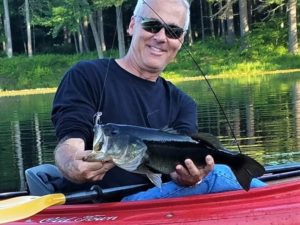If you search the mass.gov Fisheries and Wildlife website for the best places to fish in western Mass, you won’t find Fitzgerald Lake on the list.
But local anglers don’t need the government to tell them that this small body of water is an attractive and convenient spot to take a break from their daily routine and try their luck. Whether fishing alongshore or from a kayak or canoe, it’s just a short walk in from the North Farms Road parking lot to the lake, making it possible to get a bit of fishing in before or after work, on a lunch break, or whenever the urge arises. And with the newly extended dock, boaters can now launch into open water instead of fighting the muck off the end of the older, shorter boardwalk.
Like other small dammed lakes and ponds in the area, Fitzgerald Lake is fairly shallow and weedy, with a mud or silt bottom and stands of cattails or reeds at the margins. While the water is relatively open at the beginning of spring, the shallower portions eventually fill with a dense mat of pondweed, water lilies, and watershield, providing shade and cover for the largemouth bass and bluegill that are the target species for most people who fish the lake. As the vegetation starts to take over the lake surface, it takes a certain skill to cast a lure or bait into the open water along the edge of the floating leaves or pads, where a strike is most likely; a little too far, and all you’re likely to haul in is a handful of tangled stems. (So-called weedless hooks are useful in these conditions, though they typically only reduce rather than eliminate the snags.)
Though neither largemouth bass nor bluegills are native to New England, it would be hard to find a lake or pond in Massachusetts without them. Both species can be caught throughout the year, even under the ice, and both will take almost any kind of lure or live bait (if they’re in the mood). But it’s the bass that anglers are mostly after: they’re bigger, they strike harder, and they can put up a good fight, especially if you’re fishing with light tackle. Typical size for a largemouth bass is in the 10–15-inch range, weighing from a pound or two up to 5 pounds; larger fish, up to 20 inches and beyond, are possible, though fish that size aren’t often caught in lakes like Fitzgerald.
Bluegills, a kind of sunfish, are smaller than the bass, but they’re generally easier to catch and are especially fun for fishing with children. They are very similar to the pumpkinseed, which is native to New England but not as numerous as the introduced bluegill.
The two species are often found together in small schools, especially at the edge of weed beds or around sunken logs. Other panfish that are likely to be present in Fitzgerald Lakebased on its similarity to Lake Warner, which was sampled by Mass Fish and Wildlife in 1981– are the black crappie, white crappie, and yellow perch, all of which are considered to be excellent eating.
You can fish for freshwater species all year long in Massachusetts with few restrictions.
A license is required for anyone over the age of 15, though it’s free for ages 15–17 and over 70. There is a creel limit of 5 bass per day and a minimum size limit of 12 inches, though of course you can catch and release as many fish of any size as you want. More information about freshwater fishing can be found at mass.gov/freshwater-fishing-in-massachusetts. Good luck to all!
Dave Pritchard
Originally published in the Fall 2017 BBC Newsletter.
